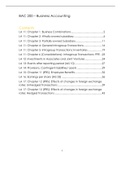Summary
Summary Business Accounting (BAC200) - Semester 2
- Course
- Institution
- Book
This document contains chapters from the textbooks: Introduction to Consolidations and Introduction to IFRS as well as lecture notes. It encompasses Learning Areas 11 - 17
[Show more]





